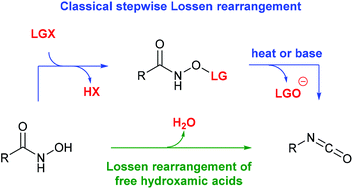The Lossen rearrangement from free hydroxamic acids
Abstract
The Lossen rearrangement, that allows the conversion of hydroxamic acids into isocyanates, was discovered almost 150 years ago. For more than a century, this transformation was supposed to occur exclusively in the presence of stoichiometric amounts of activating reagents devoted to promoting the dehydration of primary hydroxamic acids. Very recently, it was demonstrated that the Lossen rearrangement can take place directly from free hydroxamic acids offering a renewal of interest for such a reaction. This short review summarizes advances in this field by describing successively the metal-assisted, the self-propagative and the promoted self-propagative Lossen rearrangement with a special emphasis on their mechanisms.

- This article is part of the themed collection: Synthetic methodology in OBC


 Please wait while we load your content...
Please wait while we load your content...